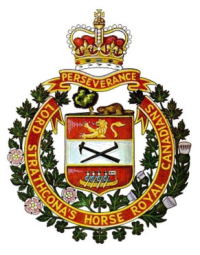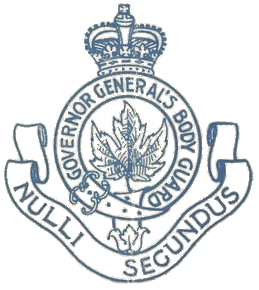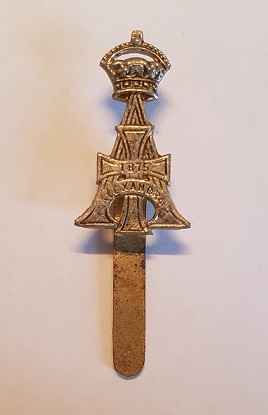
Lord Strathcona's Horse (Royal Canadians) (LdSH[RC]) is a regular armoured regiment of the Canadian Army and is Canada’s only tank regiment. Currently based in Edmonton, Alberta, the regiment is part of 3rd Canadian Division's 1 Canadian Mechanized Brigade Group. Members of the regiment are commonly called Strathconas or Strats as a short form. It was one of the last regiments in the British Empire to be created and raised by a private individual, Donald Alexander Smith, 1st Baron Strathcona and Mount Royal.

The South Alberta Light Horse (SALH) is a Canadian Army armoured cavalry regiment of the Canadian Army Reserve. It traces its complicated lineage to the Rocky Mountain Rangers, and claims its direct ancestry to the 15th Light Horse, along with various other Alberta based cavalry units. The "Light Horse" designation comes from its light cavalry and mounted infantry origins.

The Royal Canadian Hussars (Montreal) (abbreviated as RCH) is an armoured reconnaissance regiment of the Primary Reserve in the Canadian Armed Forces. It is one of the oldest cavalry regiments in North America, tracing a direct history to the Montreal Volunteer Cavalry formed in the late eighteenth century. Its Colonel-in-Chief is Her Royal Highness, the Princess Royal, and its allied regiment is the Queen's Royal Hussars. Its mission consists of supporting the Regular Force in operational deployments, peacetime tasks, and supporting the civilian authorities.

The Governor General's Horse Guards is an armoured cavalry regiment in the Primary Reserve of the Canadian Army. The regiment is part of 4th Canadian Division's 32 Canadian Brigade Group and is based in Toronto, Ontario. It is the most senior reserve regiment in Canada, and the only household cavalry regiment of Canada's three household units.

The Governor General's Body Guard was a royal guard regiment of the Canadian Army that formed part of the country's household troops. The Body Guard was the senior regiment of the Canadian Army and the equivalent of the British Army's Life Guards and Royal Horse Guards. In 1936 the regiment amalgamated with the Mississauga Horse to become The Governor General's Horse Guards.

The Royal Canadian Dragoons (RCD) is the senior armoured regiment of the Canadian Army by precedence. It is one of three armoured regiments in the Regular Force and forms part of the Royal Canadian Armoured Corps.

The 1st Hussars is an armoured Primary Reserve regiment of the Canadian Armed Forces, based in London and Sarnia, Ontario.

The 13th Hussars was a cavalry regiment of the British Army established in 1715. It saw service for three centuries including the Napoleonic Wars, the Crimean War and the First World War but then amalgamated with the 18th Royal Hussars, to form the 13th/18th Royal Hussars in 1922.

The 12th Manitoba Dragoons is an armoured regiment of the Canadian Army that is currently on the Supplementary Order of Battle.

The 19th Alberta Dragoons was a cavalry regiment and later an armoured regiment of the Canadian Militia and later the Canadian Army. It was placed on the Supplementary Order of Battle in 1965. In 2006, it was taken off the Supplementary Order of Battle and amalgamated with the South Alberta Light Horse.

The 19th Royal Hussars (Queen Alexandra's Own) was a cavalry regiment of the British Army, created in 1858. After serving in the First World War, it was amalgamated with the 15th The King's Hussars to form the 15th/19th The King's Royal Hussars in 1922.

The 18th Royal Hussars (Queen Mary's Own) was a cavalry regiment of the British Army, first formed in 1759. It saw service for two centuries, including the First World War before being amalgamated with the 13th Hussars to form the 13th/18th Royal Hussars in 1922.

The 8th King's Royal Irish Hussars was a cavalry regiment in the British Army, first raised in 1693. It saw service for three centuries including the First and Second World Wars. The regiment survived the immediate post-war reduction in forces, and went on to distinguish itself in the battles of the Korean War, but was recommended for amalgamation in the 1957 Defence White Paper prepared by Duncan Sandys. The regiment was amalgamated with the 4th Queen's Own Hussars, to form the Queen's Royal Irish Hussars in 1958.

The 15th The King's Hussars was a cavalry regiment in the British Army. First raised in 1759, it saw service over two centuries, including the First World War, before being amalgamated with the 19th Royal Hussars into the 15th/19th The King's Royal Hussars in 1922.
The 15th Canadian Light Horse was a light cavalry regiment of the Non-Permanent Active Militia of the Canadian Militia. First formed in 1905 as the 15th Light Horse, the regiment was redesignated in 1920 as the 15th Canadian Light Horse. In 1936, the regiment was Amalgamated with The South Alberta Horse to form the 15th Alberta Light Horse.

The 2nd Canadian Mounted Rifles Battalion, was authorized on 7 November 1914 as the 2nd Regiment, Canadian Mounted Rifles, CEF. The battalion recruited in Victoria and Vernon, British Columbia and was mobilized in Victoria. An earlier incarnation was raised for Boer War.

The British cavalry were the first British Army units to see action during the First World War. Captain Hornby of the 4th Dragoon Guards is reputed to have been the first British soldier to kill a German soldier, using his sword, and Corporal Edward Thomas of the same regiment is reputed to have fired the first British shot shortly after 06:30 on 22 August 1914, near the Belgian village of Casteau. The following Battle of Mons was the first engagement fought by British soldiers in Western Europe since the Battle of Waterloo, ninety-nine years earlier. In the first year of the war in France, nine cavalry brigades were formed for three British cavalry divisions. Other regiments served in six brigades of the two British Indian Army cavalry divisions that were formed for service on the Western Front. Three regiments also fought in the campaign in Mesopotamia, the only other theatre of the First World War where British cavalry served.
The Manitoba Horse was a cavalry regiment of the Non-Permanent Active Militia of the Canadian Militia. First formed in 1912 as the 32nd Light Horse, the regiment was redesignated later that same year as the 32nd Manitoba Horse and again in 1920 as The Manitoba Horse. In 1936, the regiment was amalgamated with The Fort Garry Horse.
The Manitoba Mounted Rifles was a cavalry regiment of the Non-Permanent Active Militia of the Canadian Militia and later the Canadian Army. In 1946, the regiment was converted to artillery.
The 16th Canadian Light Horse was a light cavalry regiment of the Non-Permanent Active Militia of the Canadian Militia. First formed in 1905 as the 16th Mounted Rifles, the regiment was Redesignated in 1908 as the 16th Light Horse and again in 1920 as the 16th Canadian Light Horse. In 1936, the regiment was amalgamated with The Saskatchewan Mounted Rifles to form the 16th/22nd Saskatchewan Horse.
















